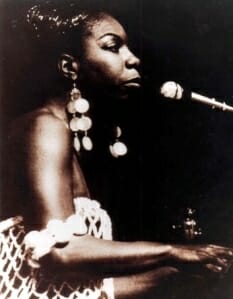
By shelz.
There usually is very little balance between music and the business of music. Artists either forsake their champagne wishes and caviar dreams for their artistic vision or they bow to the suits and compose as they are told. The former path leads to the realm of the starving artist. The latter comes with hopes that abandoning the artistic merit will pay dividends at travels end. However, every once in a while, an artist comes along who manages to do both. With undeniable power and voice, these unique performers defy without interference and still produce material that they can strong arm the boys in charge into accepting. One such artist was the incomparable Nina Simone.
A creative spirit even in early childhood, Simone (born Eunice Waymon) trained as a classical pianist starting at the age of three in her home state of North Carolina. And it was during her childhood that Nina bound her artistry and her ethical inclinations. She stopped midway through her first childhood piano recital and refused to continue until her parents, who had been moved to the rear of the hall to make room for white patrons, were moved back to the front row. She was 12 years old.Her refusal to accept disrespect of her art or race would reappear regularly through the duration of her career.
After studying at Julliard, Simone spent her early twenties playing small clubs to pay for her continued music training, yet managed to garner a recording contract in 1958 with Bethlehem Records. The contract only yielded two albums and a $3000 payment, but led to a more substantial deal with Colpix Records a couple of years later. It was during her tenure with Colpix that Simone demanded complete creative control. It was an uncommon demand for most artists, but it was unheard of from a black woman. Colpix agreed.
Her sound with her new label brought a depth to black American recording rarely heard before. She infused material into her repertoire such as “Brown Baby” that spoke of pride, strength and self love instead of the blues soaked tales of woe or party anthems on regular rotation in early 60’s black music. However, once she let Colpix go for her next label, Dutch Phillips, Nina dove into America’s rabid institutional racism, bigotry and socio-economic disparities head first.
Her first passion-filled offering that displayed the shift in her attitude was an angry dedication to racial violence, “Mississippi Goddamn.” It was a musical response to the murder of Medger Evers and the bombing of the 16th Street Baptist Church in Birmingham, Alabama that killed four little girls. The song, rife with confusion, pain and a desire to push the civil rights movement to a new level of expediency was banned in many southern states. However, this did not stop Ms. Simone from using her art to reflect her anger with the racial politics of the 60’s. From her simply structured and wonderfully obstinate look at the impending end of separate-but-equal in “Old Jim Crow” to her achingly sad capturing of the aftermath of Martin Luther King Jr’s assassination in “The King of Love is Dead,” Simone always managed to express the essence of the moment in stark realism and speak for an entire race who at times was speechless.
Simone continued her melodic activism through the rest of her career, covering Billie Holiday’s “Strange Fruit” as well as penning several songs that provided looks into the black experience. After moving to RCA from Dutch Phillips, Simone drew inspiration from Lorraine Hansberry’s play, Young Gifted & Black and the song she wrote of the same name was adopted as the National Anthem of Black America. However, not too long after that release, Simone found herself unable to accept the widespread mistreatment of blacks in this country and her growing disdain for the recording industry and moved abroad.
She continued to record sporadically as she moved from Barbados to Liberia and ultimately France. While some of her songs retained her somber and somewhat moody trademark, many of her livelier recordings were produced during this period of her career. It’s been said that even her live shows were affected by her move, with a much friendlier Nina sharing stories of the lighter moments of her amazing career with audience members.
 Simone released music right up until her death in 1993. Her last album, A Single Woman, was an obvious attempt by RCA at muting the undeniable emotional range and soul stirring presentation that always accompanied the songstress. The album wasn’t received well by critics but Simone may have passed from breast cancer before the ink was dry on most of the reviews.
Simone released music right up until her death in 1993. Her last album, A Single Woman, was an obvious attempt by RCA at muting the undeniable emotional range and soul stirring presentation that always accompanied the songstress. The album wasn’t received well by critics but Simone may have passed from breast cancer before the ink was dry on most of the reviews.
Nina Simone’s legacy is that of an artist who poured everything she had into each note. She was an immutable presence in the rank and file of black musicianship during a time when it was safer to be a shrinking violet. She picked her battle and fought it. And she counted her reflections of pain and solitude as an African American through her music not as a choice, but as an obligation.
“An honest duty as far as I’m concerned is to reflect the times. I think that this is true of painters, sculptors, poets, musicians. As far as I’m concerned it’s their choice, but I chose to reflect the times and the situations in which I find myself in. That to me is my duty.” ~Nina Simone
“Four Women”
“Everything Must Change”
“Baltimore”
Follow Us on Twitter @ http://twitter.com/planetill
Follow shelz. on Twitter @ http://twitter.com/shelzp
Join Us on the Planet Ill Facebook Group for more discussion




5 thoughts on “Black Music Month: Nina Simone”